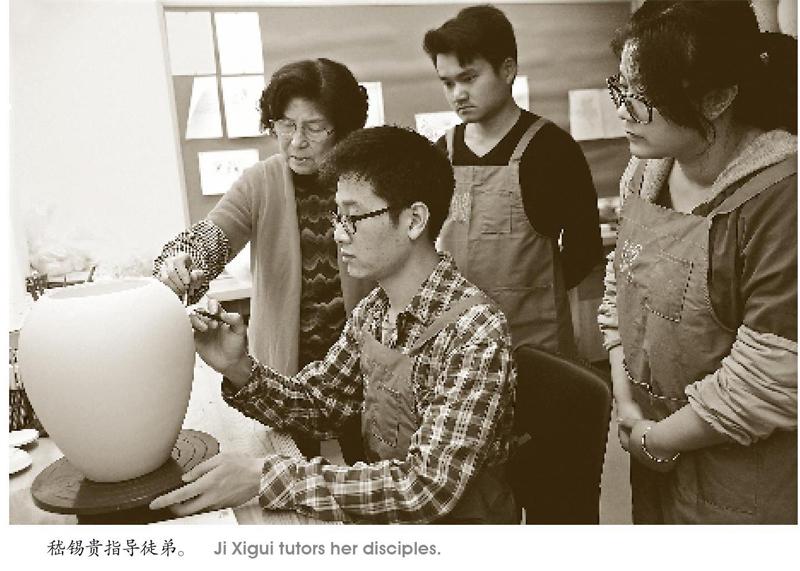嵇锡贵:让中国陶瓷艺术薪火不息
2018-05-09徐继宏
徐继宏
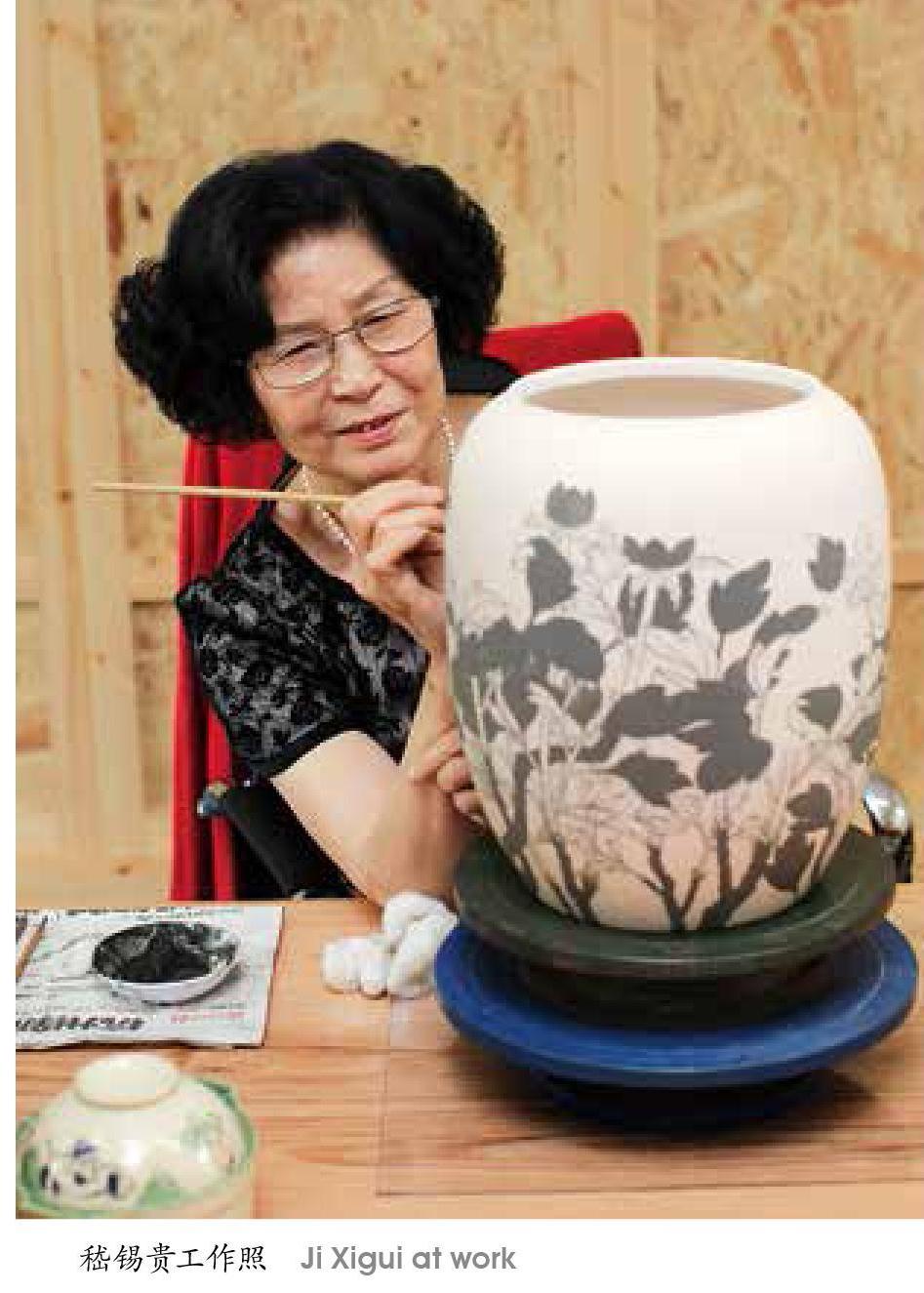
三月的西溪,繁花如锦,游人如织。
在杭州西溪贵山窑陶瓷艺术馆,笔者见到了慕名已久的中国工艺美术大师嵇锡贵。她正专心致志地伏在工作台上为作品上釉彩。
今年78岁的嵇锡贵精神矍铄,风采依旧。“陶瓷里面有许多国家级非物质文化遗产,我希望这些珍贵的艺术能永远传承下去。”如今,已经从事陶瓷艺术60多年的她,仍旧在不断地创作陶瓷艺术作品,续写中国陶瓷的美丽传说。
陶艺人家
“我有一种不服输的性格,做事一定要做到最好。这份执着,推动我不断努力,从不放弃对事业的追求。”嵇锡贵说,她在水乡湖州度过了美好的童年,初中毕业后考上景德镇市陶瓷美术技艺学校,从此走上了陶瓷艺术之路,潜心钻研,带徒传艺。
17岁担任两个班的素描课老师和一个班的班主任,而立之年担纲为中央领导人设计制作日用瓷任务,古稀之年担纲G20杭州峰会国宴用瓷设计制作重任……嵇锡贵一辈子从事陶瓷艺术一件事,倾注了一生情。
“贵山窑”是嵇锡贵和丈夫郭琳山的名字各取一字而成。1998年,杭州贵山窑陶瓷艺术研究院成立,2011年5月,嵇锡贵将“贵山窑”从三墩迁至西溪湿地,2013年杭州西溪贵山窑陶瓷艺术馆挂牌开馆。从此,绿树掩映的湿地里又多了一处耀眼的人文景观。
走进艺术馆,这里是陶瓷的世界。除了嵇锡贵,还有先生郭琳山、女儿郭艺、徒弟周明明等人的作品,都一一展放在陈列柜里,供中外游客观赏。
到艺术馆参观的游客络绎不绝。来自湖南醴阳的小王和朋友看得非常认真,在青花斗彩瓶《国色天香》前足足看了五六分钟,不停地赞叹:“太美了,太美了。”艺术馆除每周闭馆休整一天外,常年对外开放,得到了社会各界的关注和广大游客的好评。
1992年,嵇锡贵与丈夫郭琳山、女儿郭艺共同举办了陶瓷艺术作品展,著名陶瓷专家邓白先生为展览题词“陶艺人家”。从此,“陶艺人家”便成为品牌一直流传至今。在嵇锡贵看来,优秀的工艺美术品是天巧与人工的完美结合,它可以让我们感恩自然、怀念传统、感受人性的温暖。正如这些匠心独特的陶瓷艺术,展示给人的不仅是艺术之美,更是人们追求美、享受美的心灵洗涤。
“这是我和先生共同创作的‘青花斗彩佳品,以大外孙童年时的各种生活状态为原型,或露着屁股倒立、或半蹲张望、或弓步斜蹲,或起舞弄袖,每一个动作都不相同。孩童脸泛红晕,身着‘斗彩,充满天趣童真,非常讨观众喜欢。也是我们一家人非常喜欢的作品系列。”嵇锡贵指着《婴戏系列》的一组作品回忆过去的往事,脸上满是幸福的笑容,特别开心。
国宝传奇
青花瓷,广为世人熟悉。青花,其实是中国瓷器的大宗。用含氧化钴的青花料在陶瓷坯体上描绘,再罩上一层透明釉,然后进窑在1300多摄氏度的高温下淬炼。黑色的钴料烧成后呈蓝色,这就是青花的由来。在烧成的青花瓷器上进行彩绘,再二次烧制,称作斗彩。“青花斗彩是火的艺术,古代做陶瓷的艺人都要拜风火神。到了现代社会,仿佛还有一种冥冥中的神秘力量藏在炉火中。”嵇锡贵说,陶瓷艺术是一门综合艺术,可贵之处在于它风格上多姿多彩,品质上唯我独有,唯我独精。
1975年1月,嵇锡贵所在的轻工部陶瓷研究所接到任务,设计制作一批专供毛泽东主席使用的生活用瓷,代号“7501”。她担任“釉下彩”组负责人。“釉下彩”不含铅,是生活用瓷的首选,但难度最大,在泥坯上作画,成功率不足十分之一。为此,嵇锡贵和她的小组付出了巨大的努力。
“7501”千余件瓷具,大小、高低、厚薄、重量几乎等同,从设计到成品,历经10个月,每件瓷器都经过嵇锡贵的手。“那时工作条件极差,天气炎热,没有空调。经常通宵加班,但没有人叫苦叫累。”此事虽已过去40多年,嵇锡贵记忆犹新。
“7501”餐具无论原料、成型、彩绘还是烧成,都堪比历代陶瓷,制作极为精美,代表了中国现代陶瓷艺术制作的最高水平,成为我国陶瓷历史上的国宝。据说,散落在民间的这一批瓷器经过多次溢价,现在一只小小的调羹,都已经卖到十多万元。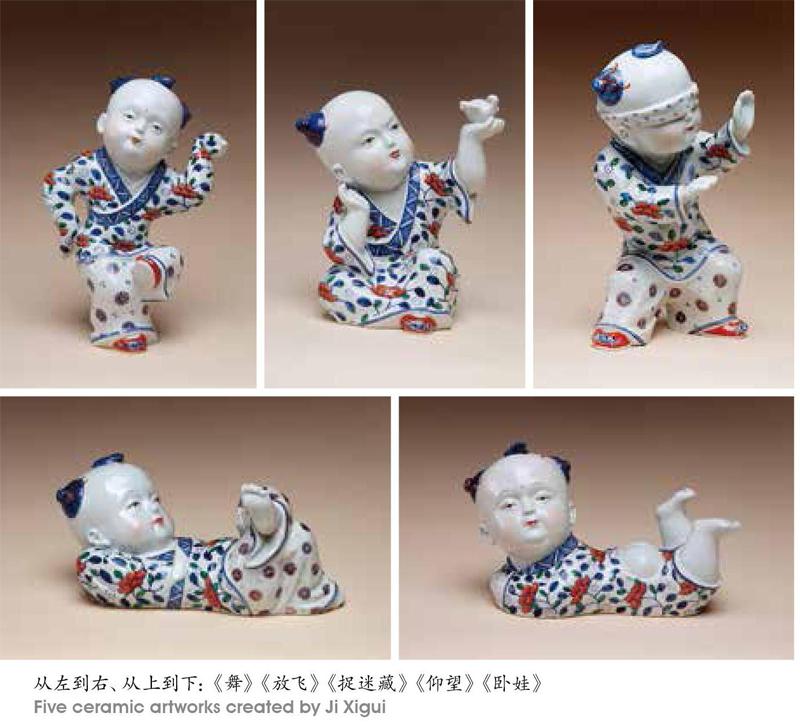

2015年,75岁的嵇锡贵,又接到一个新任务——设计G20杭州峰会晚宴餐具。根据设计要求,作品需体现“西湖元素、江南韵味、浙江特色、中国气派、世界大同”的理念。
由于时间紧迫,接到任务后,她带着徒弟们立马动手。最忙时,凌晨3点多起床,晚上12点多睡觉,设计图纸累积有20多厘米高。经专家评审,嵇锡贵设计的三套方案全部入选。“西湖韵”“繁华盛世”“国色天香”三套瓷器分别对应G20杭州峰会三场宴会的三个不同主题,受到了专家评委的一致好评。
2016年9月4日晚,G20杭州峰会欢迎宴会上,摆在餐桌上的一整套晚宴餐具一亮相,就惊艳全场,尤其是瓷器上的花面,水墨氤氲,山色空蒙,让人有一种就坐在西湖边把风景看透的感觉。来自各国的贵宾纷纷伸出大拇指点赞。“贵山窑”师徒的技艺,再次获得社会的赞扬和陶瓷界的认可。
嵇锡贵最满意的是5日晚金砖五国在西湖国宾馆晚宴用的青花斗彩《繁华盛世》。嵇锡贵说,一开始,作品上面用到了22个国家的国花,后来,世界各地有名的花也都摆上去了。比如日本樱花、韩国木槿花、俄罗斯向日葵、法国玫瑰、意大利小雏菊,一共有30多种花,都用不同的颜色表现出来。
嵇锡贵晒出一张楼兰浅盘的照片,青瓷上繁花遍地,但花中间“开光”。嵇锡贵说可以理解成繁花间开出一个窗子,里面是西湖的三潭印月。实际上,它有两个面,从北面往南面看,白堤、断桥,然后对应了荷花。从另一面看,雷峰塔、苏堤,然后对应到桂花。“荷为桂,和为贵。而荷花和桂花,也是杭州最典型的兩种花。”嵇锡贵说,这是一层层剥进去的,这一套,她自己觉得最精彩。
“我一生的夢想,就是让中国的陶瓷艺术在全世界发光发彩。而G20杭州峰会是一个非常好的展现机会和舞台。”
薪火传承
“我们这代人的成就与国家的培养分不开。我到了一定的年纪,依然停不下来,想着要多做些事情回报社会。现在,我除了创作作品之外,就是要把更多的精力花在带徒、教授学生上,要把自己的技艺经验传承给年轻人。就像当年我的老师们一样,不仅要传授技艺还要传承工艺精神。只有这样,陶瓷艺术才能代代相传,薪火不息。”
2012年9月,杭州市举办薪火传承计划,嵇锡贵收了5个徒弟。入门第一天,嵇锡贵就要求徒弟们苦练基本功。从画线条开始,到每周两张素描写生,画好后钉在工作室的墙上。
“在我这里,要想把一坨泥巴变成一件瓷器,就必须实打实地认真做好揉泥、拉坯、刻花、上釉、烧窑……等72道工序。”每一道工序,嵇锡贵要求都非常苛刻,她自己也是毫无保留,手把手地教好每一个学生。5年过去了,如今,每人的作品图片装订起来,已是厚厚好几本。
毕业于江西景德镇陶瓷学院的甄景虎感受到了老师的泽润。当初,得知嵇锡贵同意收他为徒,已有10余年制瓷功底的他,毫不犹豫关闭了经营多年、有40人规模的瓷厂,坐上了从景德镇开往杭州的列车。
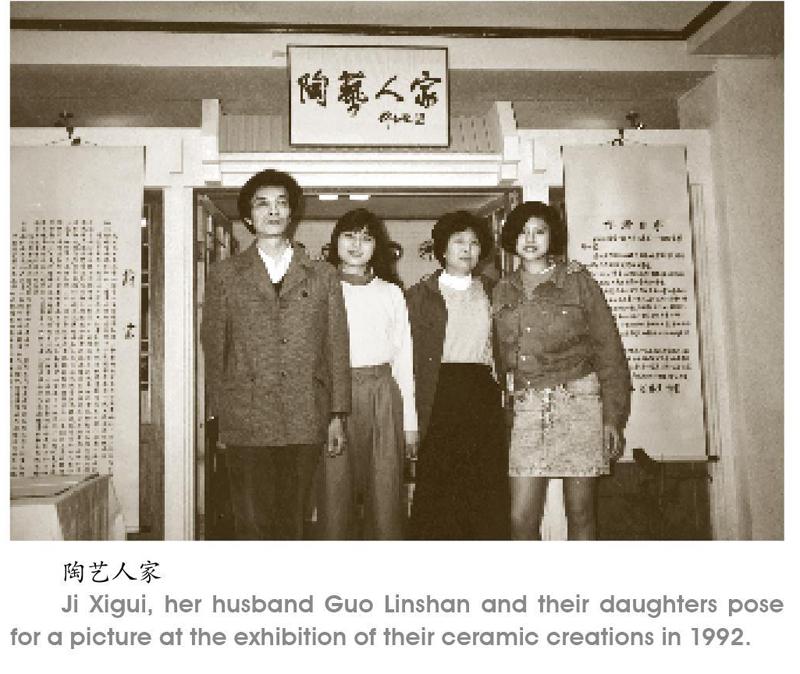
在徒弟周明明看来,嵇锡贵更像一位可爱的奶奶,用羽翼呵护着每一个跟她学艺的徒弟。奶奶不仅将自己的陶瓷技艺倾囊相授,还把每一个徒弟的生活考虑得非常仔细和周到,包括为他们办理社保、过好每一个节日等。嵇锡贵认为,自己有责任帮助徒弟们生活得更好,生活好才能传承好。
在艺术馆二楼,笔者看到了许多奖牌和作品。“这些都是徒弟们参加国内外各种比赛捧回的奖状和证书。陈兴圆的工笔画出彩;徐周萍擅青瓷刻花;张爱青陶瓷雕塑技艺突出;甄景虎釉中彩技法娴熟;周明明制作的器物装饰趣味浓。”嵇锡贵对每个徒弟的长处了然于心,对他们未来的艺术之路充满了信心。
从感受自然到艺术地再现自然,嵇锡贵用个人的艺术才华阐释客观世界,在这之中融入了她对人生、对世事的感性理解。“艺术家应该尊重自己的感受,我总希望把我的这份真诚表达出来,这也许是我的性格吧。人在世间的生存,本来就要经过许多磨难,但大自然的赐予弥补了我们许多许多。我热爱大自然,宁静舒坦的田园风光,微风细雨中的小花小草,残阳如血的层林,晨露中的蜘蛛网,活泼可爱的小动物等,都使我的心灵震撼,成为我表现的形象。民间美术的朴拙、中国画的神韵和西画色彩的绚丽都给予我养分。利用陶瓷颜料的烧成特性,可以取得纸上所达不到的效果。”
最是人间芳菲季,艺无止境续新篇。生命不息,传承不止。采访结束,走出艺术馆,看到门口亭立的一株海棠树,枝繁叶茂,花开正艳。嵇锡贵说她非常喜欢海棠,因为它在平日里从不起眼,花开的时候却满树红颜,讨人喜爱。
笔者想,这不正是嵇锡贵艺术人生的真实写照吗!
(本文图片由作者提供)
Ji Xigui, now 78, is a national ceramic master based in Hangzhou. She has long since made her reputation as a virtuoso. Set in the scenic Xixi Wetland in the western suburb of Hangzhou is a ceramic museum named after Guishan Kiln. The name of the kiln comes from the names of Ji Xigui and her husband Guo Linshan.
Ji Xigui started Guishan Kiln Ceramic Art Institute in 1998. In May 2011, the kiln was moved to the scenic wetland and in 2013 the museum opened to the general public. The museum displays Jis artworks as well as those by her husband Guo Linshan, their daughter Guo Yi, and Jis disciples. Nowadays, the museum is a huge tourism attraction of Xixi, which is a national park.
As a ceramic master, Ji has a star career track record. There are two landmarks in her 60-year career.
The first was set up in January 1975 when the ceramic institute under the Ministry of Light Industry where Ji Xigui worked was engaged in designing and making some ceramic household pieces for Chairman Mao. Ji was appointed to head a group of artists who were to paint color images onto the bodies of ceramics before the glaze layer was applied. It is extremely tricky and challenging to paint onto the body directly. Back then, the rate of success was 10 percent. Ji and her colleagues worked hard. Altogether they painted more than 1,000 pieces in ten months. Ji left her touch on all of them. She remembers the hard work vividly in the ten months. “Conditions at the place of work were extremely disheartening. There was no air-conditioning. We often worked overtime. But nobody complained,” she recalls.
The pieces they made in 1975 are so sophisticated and exquisite that they could shine beside the best antiques made in the long-gone dynasties in history. It is said that these pieces are the finest ever made in modern times and are considered by collectors as valuable as national treasures. Many pieces from the batch have long since been in the market. It is said that a spoon from the batch can fetch more than 100,000 yuan.
The second highlighted event in her resume occurred in 2015 when the 75-year-old master was engaged in designing ceramic tableware for the state banquets of the G20 Hangzhou Summit to be held in September 2016. The tableware was supposed to feature “the elements of the West Lake, the charms of Jiangnan (the south of the Yangtze River Delta), unique characteristics of Zhejiang, the grace and elegance of the great Chinese nation, and the harmony of the world”.
Ji Xigui and her younger colleagues, all being her students, worked hard against time. In the busiest times, they got up at three oclock in the morning and didnt retire until midnight. The design drawings they produced were more than 20 centimeters thick in a stack. The three sets of tableware they designed won the final approval of an expert panel. The sets, respectively named as “Charms of West Lake”, “Time of Prosperity”, “National Tints and Celestial Fragrance”, were respectively used at the three banquets at the G20 Hangzhou Summit.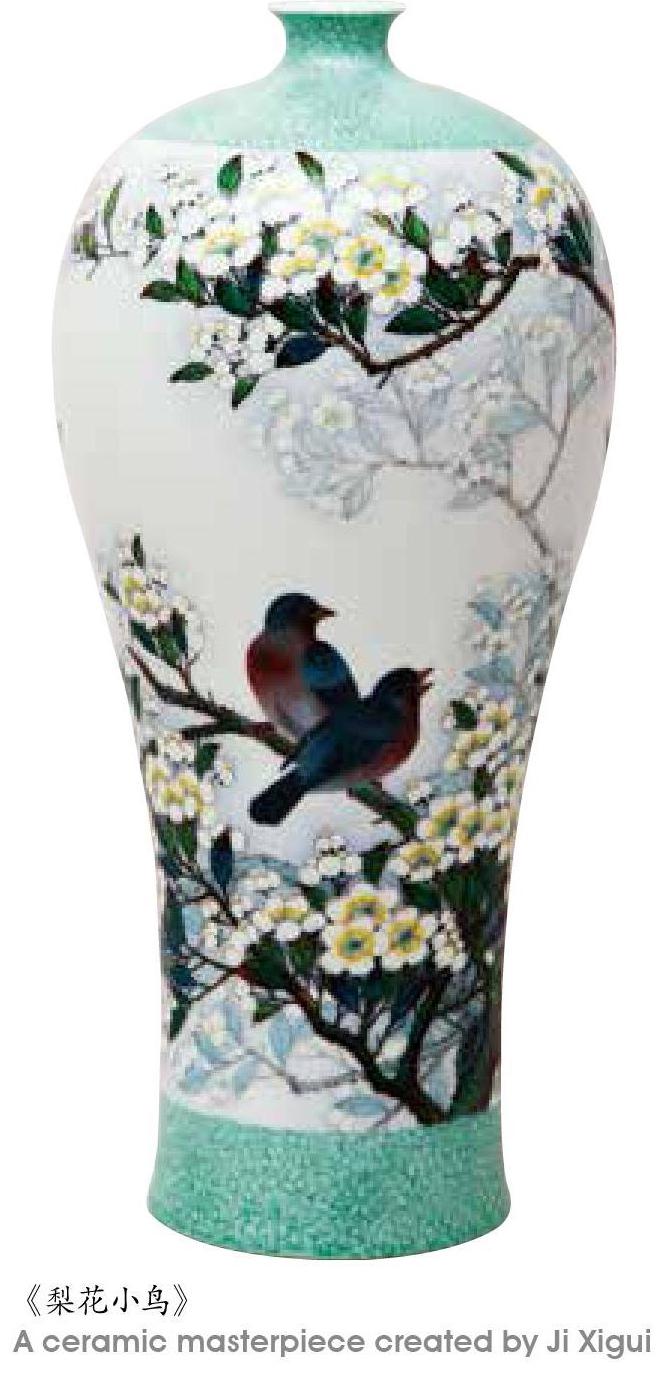
Nowadays, Ji most wants to give what she can to her younger masters. In September 2012, Ji Xigui took in five students in response to Hangzhou Citys call to groom a new generation of masters of traditional arts and crafts. On the first day, she gave her students a very clear instruction: start from basics and work hard. The five needed to submit two sketches per week and these sketches went on the wall of the studio for them to view and compare.
Ji Xigui is a draconian taskmaster. In her general training course, there are 72 steps for making a ceramic piece. All the five students must master each step through hands-on practice and training. And she is more than a taskmaster. She treats her students like family members and reaches out to solve problems for them in everyday life.
Zhen Jinghu, a graduate of Ceramic Institute of Jingdezhen and owner of a ceramic business which employed 40 people, shut down the factory after learning that Ji Xigui agreed to take him in as a disciple. He valued the lifetime opportunity to study under the master.
To Jis satisfaction, her young masters are making themselves outstanding in different fields of ceramic making. Chen Xingyuan is becoming perfect in painting on ceramics in a precise leaving-no-detail-out style. Xu Zhouping masterfully carves flowers on celadon. Zhang Aiqing stands out as a ceramic sculptor. Zhen Jinghu paints between glazes. Zhou Mingming makes fine decorative pieces. Ji Xigui understands the strengths of her students and is confident of their career growth in the future.